How I am Adapting my Art to Reduce my Carbon Footprint
Becoming an Environmentally Friendly Artist
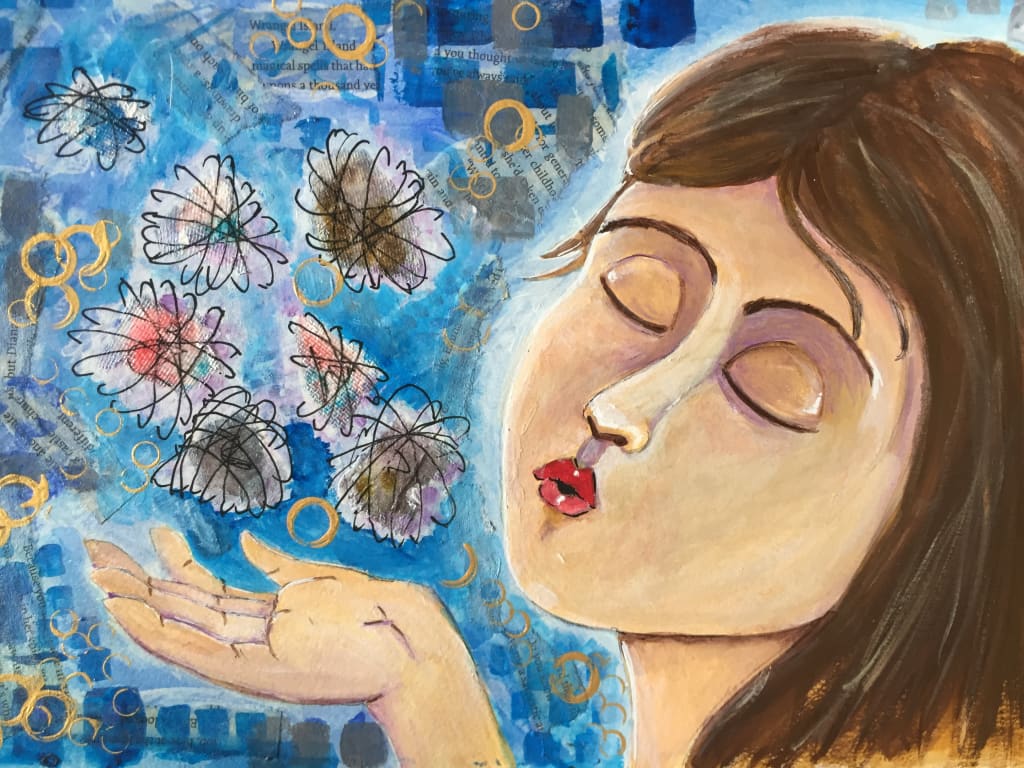
My art is a source of respite and restoration for me. It is something I cannot live without. I craft in many forms and formats, from making cards for loved ones, to painting works in mixed media.
One theme my art returns to time and time again is the environment and the natural world. I love to paint scenes of plants and animals. I am fortunate to live near the ocean and the sea is a huge inspiration in my art, featuring in it often.
My art frequently reflects the environmental impact we are having on our oceans. I see this first hand whenever I walk along the beach. The debris of humanity is everywhere, from discarded plastic containers, to fishing line. I do my part to remove these items before they can prove harmful to wildlife, but it sometimes feels a drop in the ocean (excuse the pun) in the battle against the environmental damage we as a species are generating.
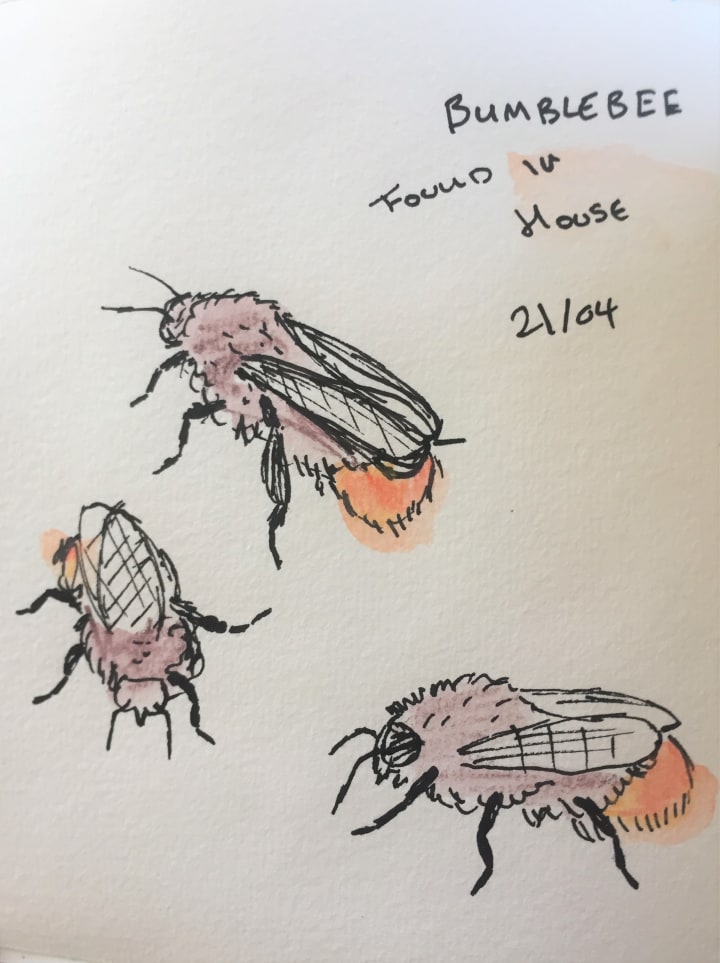
One of my weirdest pieces of artwork is one I created to try to highlight this situation. I took a used Coca Cola can, cut it in half and painted a mermaid on the inside. The way she was drawn she looked like she was screaming to get out, banging on the sides of the can. She was pretty tricky to paint because none of my paintbrushes would fit into the curve of the can, so I ended up using a cocktail stick with tiny amounts of paint on it.
But while drawing art pieces that highlight our destruction of the sea is one thing, I wanted to take the next logical step with my art and craft. I wanted to be a responsible artist who was doing all she could to avoid contributing to the problem of environmental damage.
Sounds simple, right? How damaging to the environment can art be? Well, quite simply a lot more damaging than it might at first appear. As in all industries, art has become a market of consumable and disposal goods, from single-use paint palettes to disposable aprons, gloves and all the plastic included in products to improve its texture or durability.
There had to be ways to improve my carbon footprint in my studio while still enabling me to be free with my creativity.
I began a journey to be an environmentally artist and these are my tips to follow in my footsteps.
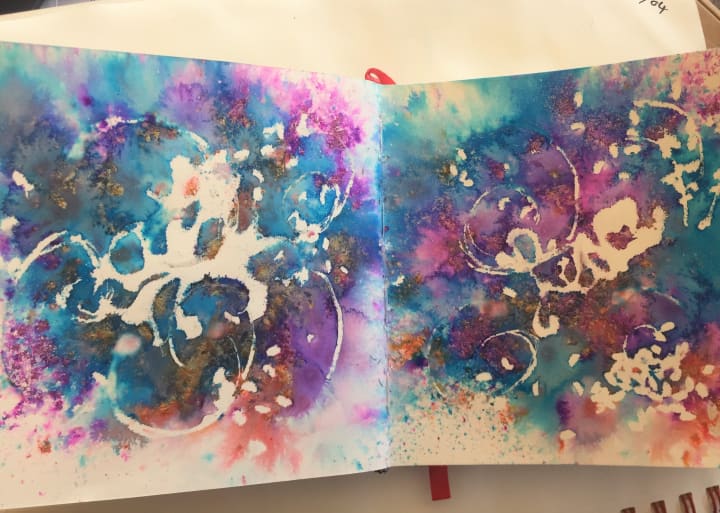
#1 Giving Up Glitter
I love sparkle and shine. I am a bit of a magpie when it comes to a bit of glitz in my art, but the unhappy news is that glitter is very unfriendly to the environment.
Glitter is made from plaster and it cannot be recycled, so using it on greeting cards, wrapping paper or any form of disposable item is best avoided as these items, once finished with, have to go straight to the landfill.
But the biggest impact from glitter is in our waterways. Being a micro-plastic often used in cosmetics, it is regularly washed down sinks and ends up back in the aquatic ecosystem. Glitter negatively affects the primary producers at the base of the aquatic food chain, according to a 2020 study by Anglia Ruskin University. The ecological impacts of this micro-plastic can be devastating in a short period of time.
And, as it turns out, so-called eco-friendly glitter that is biodegradable is even worse. Not only does it have the same effects on the organisms at the bottom of the food chain, but it encourages the growth of the invasive New Zealand Mud Snail.
If all glitter is bad, how can I get some sparkle in my art without harming the environment? Firstly, I only use sparkle in items that will not be disposed of (so not cards, tags, wrapping paper, or anything throw away). Secondly, I avoid loose glitter and prefer to use paints that contain a shimmer (check out below how I keep my paint use environmentally friendly). Thirdly, I try to use recycled shine, such as elements cut from cards that have been sent to me so that I am reusing a product that would otherwise end up in the landfill.
I do have a lot of glitter products left over from before I knew about the problems it caused and I am slowly using these up, but will not be replacing them once they are gone. I am still looking for environmentally-friendly shimmer and when I find the perfect product, I will let you know.
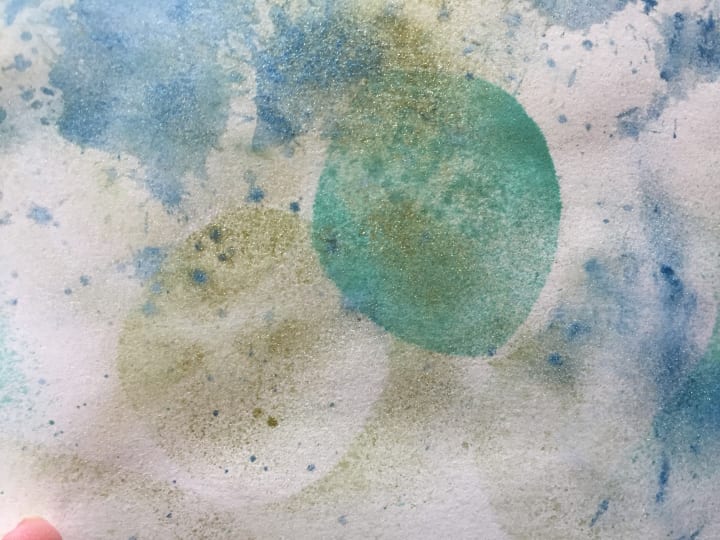
#2 Using Found Objects as Natural Art
As a mixed media artist who enjoys experimenting with abstraction using stencils and masks, I like to use found items as part of my art rather than adding further to my store of plastic. Stencils are typically made of thin plastic and depending on the intricacy of their design, sometimes only have a limited lifespan before they become worn or clogged, despite best attempts at cleaning. Then the only place for them is the bin.
Wanting to reduce my plastic usage while still being able to use stencils in my work has necessitated becoming creative and turning to the natural world for solutions.
First off, let me quickly explain the difference between a stencil and a mask. Both are usually made of plastic, though masks can also be made from paper. A stencil has a design cut into it and ink or paint is dabbed or sprayed over the stencil so it fills the holes in the design and creates an image. Masks, in contrast, block an area of a design and you spray over them, leaving a silhouette image beneath a mask.
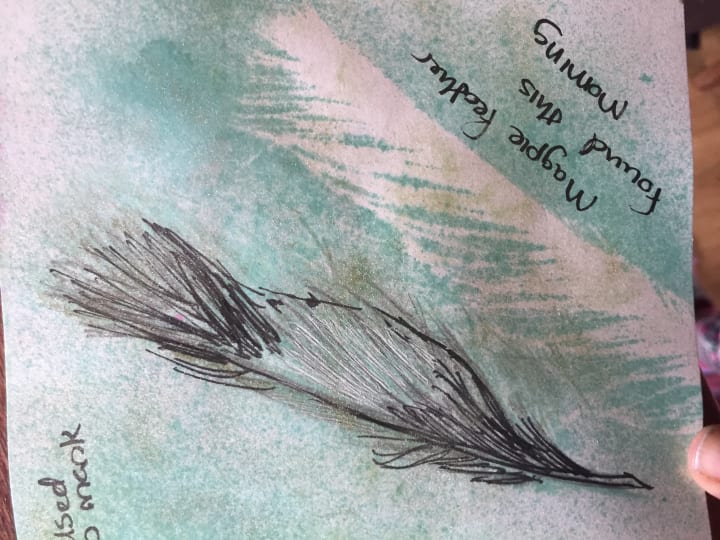
Lots of natural objects form simple masks, but one of my favourites is a feather. I find feathers when I am out walking the dogs and I bring them home to use in my art. Placing a feather on a page and then spraying over it leaves a negative impression of the feather when removed. You can then flip the feather and press it onto the paper to create a stamped image. Of course, now the feather is covered in paint it is not very environmentally friendly, but that is resolved by incorporating it into a mixed media project, so it becomes a permanent piece of art in its own right.
Other things that make wonderful masks include rice – paella rice is my favourite – when sprayed over it gives the impression of petals and you can manipulate it into different designs on the paper before spraying to get interesting effects. Once used, the rice is now also decorative and can be added to other artwork.
Leaves, grasses, pebbles, lentils, chickpeas and even pasta also create organic masks without the need for plastic.
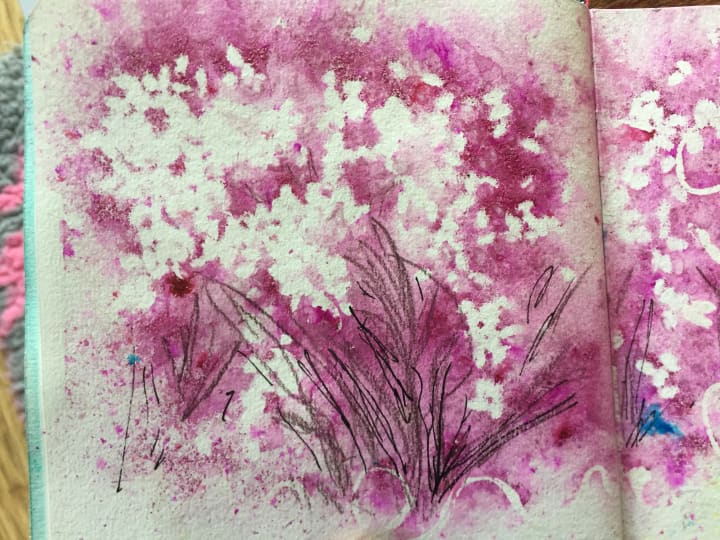
Stencils are not so easy to find in nature, but I do make my own using dies. Dies work with a machine to press an image through a piece of card or even thin wood. They are made from metal and last indefinitely if well looked after. When a die cuts out an image it leaves behind a shape or design. These waste bits are often thrown away, but mine come into artistic service and are used as stencils.
When the card reaches a point where it has been used so often it is no longer viable as a stencil, I cut it up and use it in my mixed media as a collage material. That way I have zero waste from my die cutting.
#3 Recycling My Waste Materials (Absolutely everything!)
Being a mixed media artist has one great advantage in that anything – literally anything – can become part of your next artwork. I have become quite a recycler when it comes to my art, preventing items going to the landfill and instead turning them into something beautiful.
Let’s start with kitchen towel, the standby for any artist for blotting mistakes, dabbing brushes upon and keeping handy for spillages. I go through quite a few rolls and once the sheets are coated in paint, glue and similar smears they cannot go into the recycling bin.
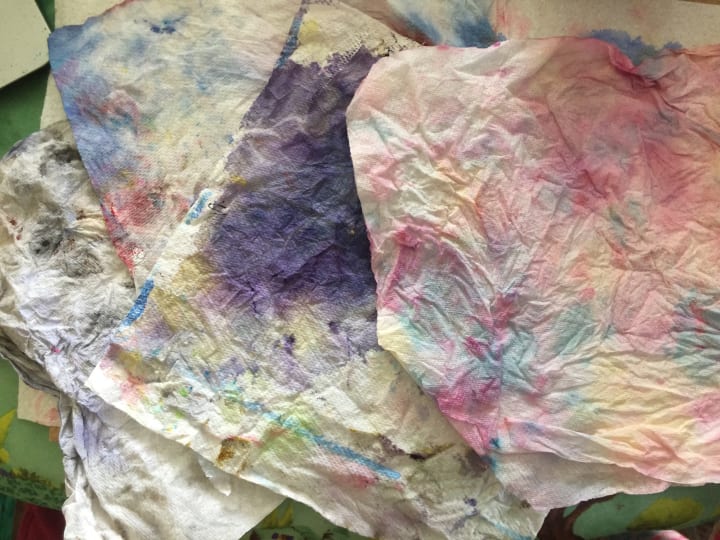
Rather than simply throwing them away, I keep these messy sheets. I spread them out, let them dry and then I see the pretty patterns emerge from them. I use them as collage materials, either as a background that disappears under other layers or using them more directly to create an image. Saves a lot on buying collage papers and there are several things I love about reusing paint stained kitchen towel.
- When it glues down it becomes see-through, allowing the background to shine and enhancing the paint dabs it is covered with.
- Watercolour paint on a kitchen towel reactivates with the glue and not only becomes darker and more intense but can flow a little and create new effects.
- Kitchen towel leaves a subtle texture to the page, creating interest to the finished piece.
- Kitchen towel, even when thickly smeared with glue (gel medium) remains absorbent when applying fresh wet paint and changes the way the paint reacts.
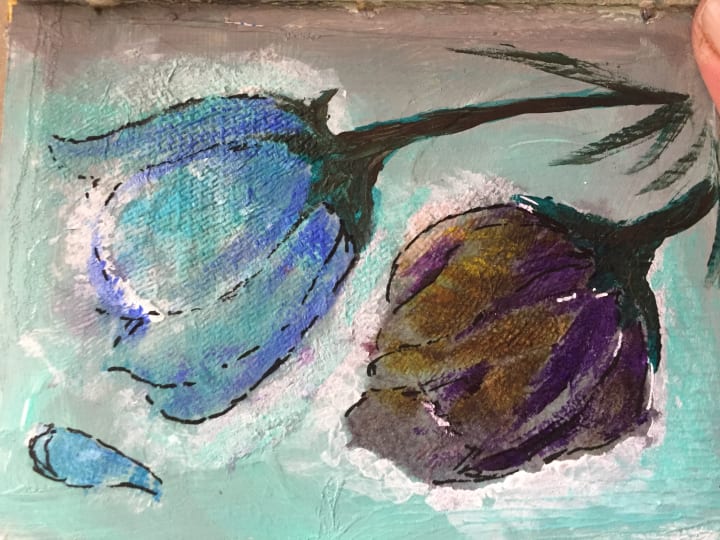
One of my favourite things is create flowers from my stained kitchen towel. I pick sections of the towel which have a flower like look, often quite vague, then I stick them down over a background and enhance the flower detail with extra paint and outlining. The finished effect looks a little abstract and has a depth to it you could not get simply with paint.
Another favourite recycling material is cardboard. I use thinner cardboard (such as from a cereal packet) to create miniature art books that I bind by hand and paint onto. I have also made bigger books using the cardboard end board from a finished pad of paper. This makes a solid cover and I insert pages cut from old magazines which will then be painted upon.
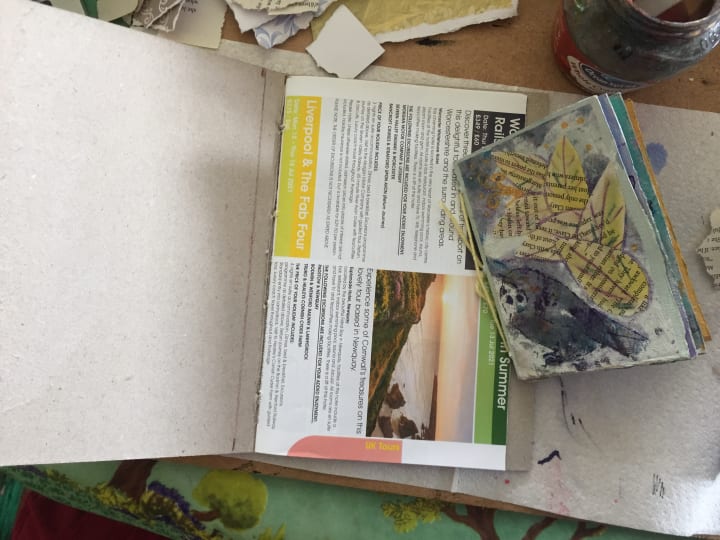
Thicker cardboard has a few uses. It can be used to make simple stamps using string glued over a pattern on a heavy square of cardboard. This ‘stamp’ can then be painted and used to create utterly unique designs. Thicker cardboard can also be used to make an art board by sticking watercolour or mixed media paper to its surface. This is handy when wanting to make unusually shaped pieces or when the finished project will have a lot of heavy embellishments or layers that will need a suitably sturdy canvas backing. Gesso down the edges masks the cardboard and gives a finished look.
Other recycled objects in my kit are my mark making tools. These are items I use to make interesting marks with paint on a project. I am particularly key on circles and use objects that make circles in different sizes. I use the cardboard tube from a toilet roll for large circles, while smaller circles can be made from screw caps off bottles, or old pen lids. The tiny plastic tubes that protect the tips of brushes when you buy them also go in my stash as they make tiny, delicate bubble shapes.
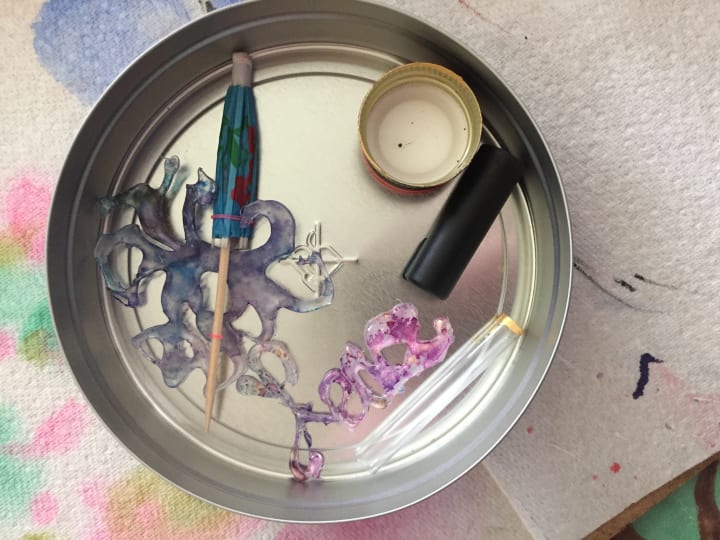
Another use for the trusty cardboard tube is as a device for masking an area when using spray inks. Depending on where you spray the ink in relation to the tube you get different effects, including speckly circles that look like pebbles or eggs.
I also hoard all manner of useful tins and jars for containing smaller items. A lot of these containers are not suitable for recycling, so by finding a use for them I am keeping them out of the landfill.
Magazines and newspapers have a multitude of uses. Newspaper obviously is good for protecting work surfaces, but once it is messed up it becomes a collage material, just like the kitchen roll. The same applies to magazines. They can be used to make pages in a homemade art book, or can be cut into for collage materials. Old books serve a similar purpose and it is often fun to find phrases and words within them that can be cut out and used in a project.
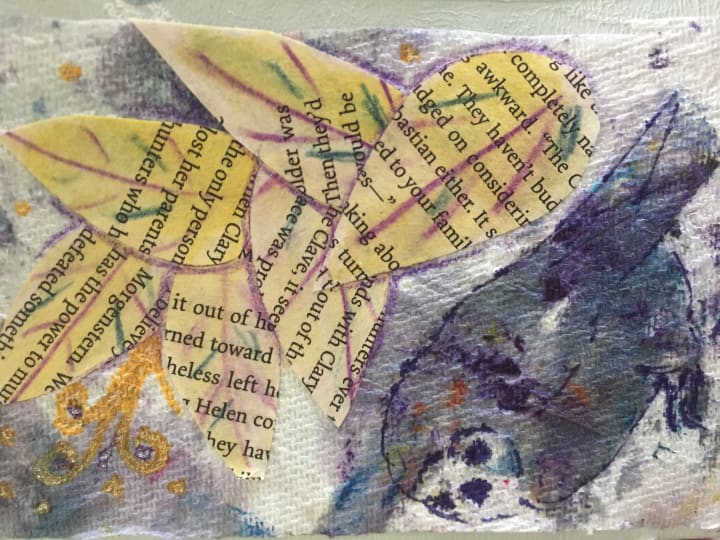
#4 Dealing with Acrylic Paint
I work a lot in acrylic mediums, but it is a material that bugs me a little due to it being made with plastic. I try to make sure I minimise my waste with my acrylic and avoid just washing excess down the sink when I am done with a project.
There are a couple of ways I handle this. Firstly, I try to avoid overloading my palette (I use a tiny palette which discourages putting out too much in one go). It is not always easy to judge amounts, so when I have paint left over I like to use it up in my art journal. I may just paint on a few layers as a background I can work with on another day. I can also paint it onto scrap cardboard or other materials to use in a future piece of collage. My aim is to have as little paint as possible left on my brush when I wash it, to stop putting acrylic down the drain and into the waterways.
My second method involves the type of palette I use. Some artists use disposable paper palettes for acrylics, which seems highly wasteful to me. Instead, I use a cheap plastic palette and leave any leftover paint to dry within it. Then, once it is dry, it will peel off the plastic and I have this intriguing plastic shape I can collect and use in my art. I like to work on old layers of paint in my palette, so that when I finally remove the dried acrylic it is this multi-coloured curious design.
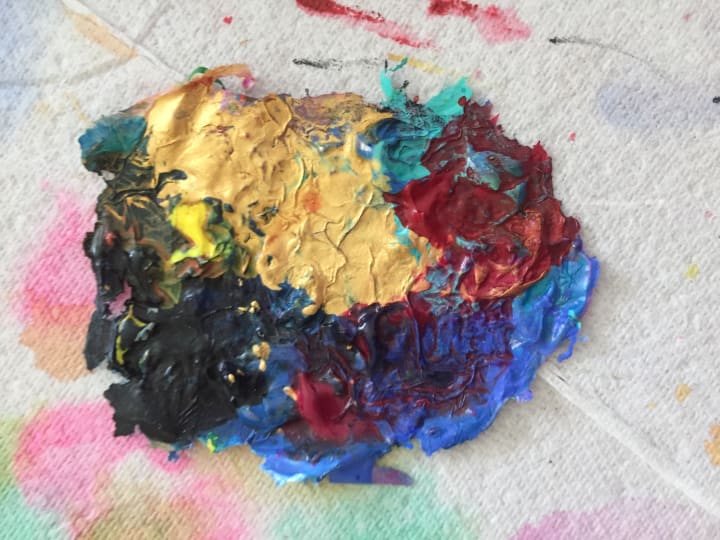
Acrylic paint remains a product that causes me concern due to its plastic content, but at this point there are no true alternatives to it, so minimising how much waste I create using it is very important to me.
My art is an expression of myself and as I work on pieces that express my views on humanity’s ongoing impact on the world and how we could change that, I like to also knowing I am doing my part. There is little in my studio that ultimately ends up in a waste bin, and I think that is the way it should be. If, in all areas of our lives, we try to diminish what we treat as disposable and recycle as much as possible, then we will all be having a positive influence on our world. I also love that my art is partly constructed from waste materials, things that had no further use.
Surely there is nothing more beautiful than transforming something deemed trash by others into treasure?
About the Creator
Sophie Jackson
I have been working as a freelance writer since 2003. I love history, fantasy, science, animals, cookery and crafts, (to name but a few of my interests) and I write about them all. My aim is always to write factual and entertaining pieces.


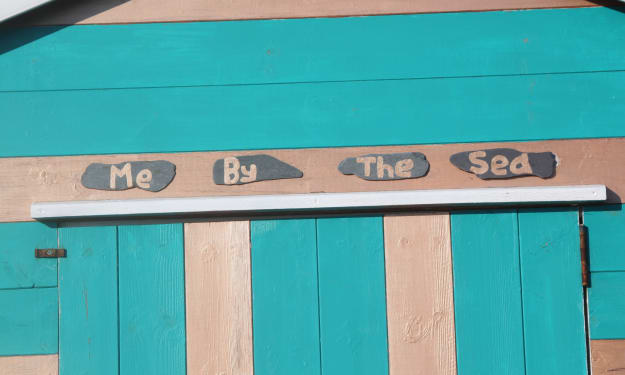

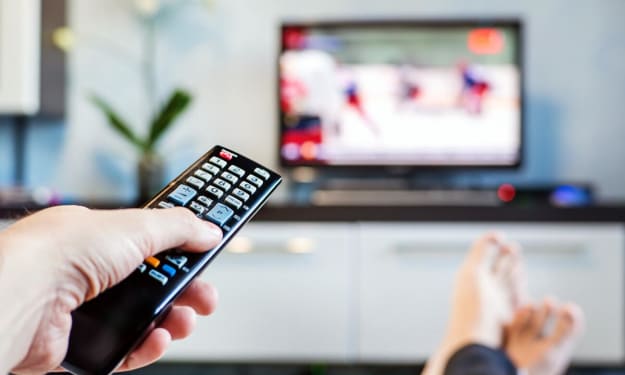
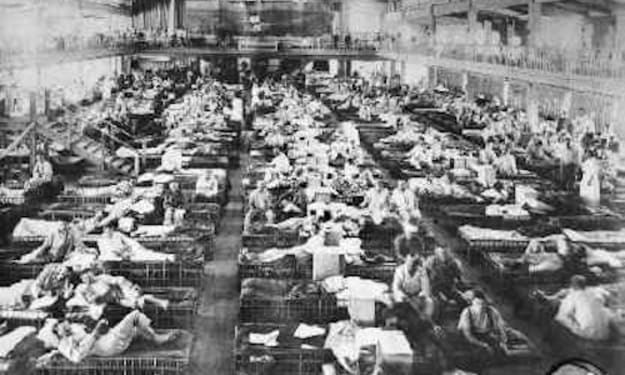
Comments
There are no comments for this story
Be the first to respond and start the conversation.